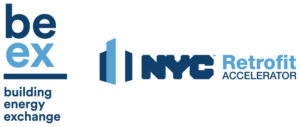Point Of Use (POU) Domestic Hot Water
Highly efficient on-demand domestic hot water that reduces emissions and maintenance costs.
Tech Overview
Applicable Buildings Types hotels, large commercial, institutional
When to Implement at time of roof replacement, mid-cycle or refinance
*Be sure to consult a qualified service provider to determine the right measures for your building.
What is Point of Use Domestic Hot Water?
Most commercial office buildings have centralized domestic hot water (DHW) systems, most often supplied by on-site boilers. Electric point-of-use (POU) water heaters, also known as “tankless” or “instantaneous” water heaters, create a decentralized heating system to provide hot water on demand without the use of storage tanks and distribution piping. POU electric domestic hot water heaters are a highly efficient retrofit option to electrify a commercial office building’s domestic hot water system.

Fig 1. When a hot water tap is turned on, cold water travels from a supply line into the POU unit where an electric element heats the water. The rate at which the water is heated varies with the rate of water flow and the required temperature rise
How to Implement
By either replacing or supplementing a traditional gas, oil, or steam hot water heating system, electric POU heaters can significantly reduce greenhouse gas emissions and save energy. There are several considerations to keep in mind when installing POU heaters. Download the full tech primer to learn more about each of the following steps:
A. Size the System to the electric load requirement of the building and consider placement of panels with allowances for shade, mechanical equipment access, and walkways
B. Install Panels using ballasted or mechanically fastened systems
C. Choose a Battery to store electricity generated by the PV system and discharge it at times of peak demand or high electricity rates
D. Install a System Monitor to give real-time readouts on voltage, current, power output, state of charge, and alerts to notify staff of functional issues
E. Obtain Green Financing from New York government programs that are available to help secure incentives and maximize investment
Cost and Benefits
Cost and benefits of a POU domestic hot water system retrofit will vary depending on your building’s baseline systems and conditions. Typically, buildings can expect to see the following results:
Greenhouse Gas (GHG) Savings
Converting a commercial office building’s DHW system to a POU system can greatly reduce DHW related GHG emissions.
Tenant Experience Improvement
Tenant experience will remain largely unchanged, however POUs allow the building to reduce emissions while maintaining consistent domestic hot water availability.
Utility Savings
While utility costs for operating POUs can be high due to the current cost of electricity, POUs consume significantly less energy than systems that use natural gas, fuel oil, or district steam.
Capital Cost
POU heaters will typically last longer and have lower operating costs that conventional storage tank water heater or boiler supplied DHW, however, the initial cost of a POU heating system is greater and depends on the number of POU heaters being installed.
Maintenance Requirement
There is little to no maintenance requirements for self-contained, decentralized POU heaters.
Take Action
This information is part of more than a dozen High Performance Technology Primers prepared by the Building Energy Exchange and the Retrofit Accelerator to introduce decision-makers to solutions that can help them save energy and improve comfort in their buildings. Curious about other retrofitting possibilities? Explore our complete library of Tech Primers here.
The NYC Retrofit Accelerator’s team of Efficiency Advisors offers free, personalized advisory services to help streamline the process of making energy efficient improvements to your buildings.
Get in touch with the NYC Retrofit Accelerator today!
Call (212) 656-9202
Visit nyc.gov/RetrofitAccelerator
Email info @nycretrofit.org
